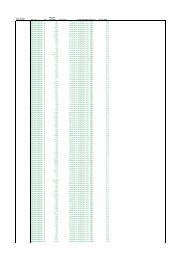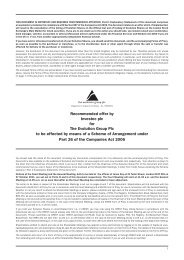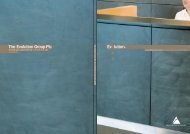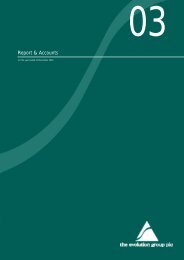Annual Report for the year ended 31 December 2008
Annual Report for the year ended 31 December 2008
Annual Report for the year ended 31 December 2008
You also want an ePaper? Increase the reach of your titles
YUMPU automatically turns print PDFs into web optimized ePapers that Google loves.
1. aCCoUntinG PoliCies<br />
Basis of preparation<br />
The Financial statements of <strong>the</strong> company have been prepared in<br />
accordance with international Financial reporting standards (“iFrs”) as<br />
adopted by <strong>the</strong> european union (“eu”) and iFric interpretations and with<br />
those parts of <strong>the</strong> companies Act 1985 applicable to companies reporting<br />
under iFrs. The Financial statements have been prepared under <strong>the</strong><br />
historical cost convention, as modified by <strong>the</strong> revaluation of available-<strong>for</strong>sale<br />
financial assets.<br />
A summary of <strong>the</strong> company accounting policies are set out below, toge<strong>the</strong>r<br />
with an explanation of where changes have been made to previous policies<br />
on <strong>the</strong> adoption of new accounting standards in <strong>the</strong> <strong>year</strong>.<br />
As permitted by section 230 of <strong>the</strong> companies Act 1985 <strong>the</strong> company has<br />
elected not to present its own income statement <strong>for</strong> <strong>the</strong> <strong>year</strong>. The company<br />
reported a profit <strong>for</strong> <strong>the</strong> financial <strong>year</strong> <strong>ended</strong> <strong>31</strong> <strong>December</strong> <strong>2008</strong> of<br />
£2,167,000 (2007: £762,000).<br />
Significant Accounting Policies<br />
Investments in subsidiaries<br />
interests in subsidiary undertakings are presented in accordance with iAs<br />
27, ‘consolidated and separate Financial statements’. An undertaking is<br />
regarded as a subsidiary undertaking if <strong>the</strong> company has <strong>the</strong> power to<br />
exercise control over its operating and financial policies. This generally<br />
accompanies a shareholding of greater than 50% of <strong>the</strong> voting power.<br />
The company’s shares in subsidiary undertakings are stated in <strong>the</strong><br />
Balance sheet at cost less provision less any impairment incurred.<br />
The carrying value of investments in subsidiary undertakings are assessed<br />
at <strong>the</strong> reporting date or whenever events or changes in circumstance<br />
indicate that <strong>the</strong> carrying amount may not be recoverable. The impairment<br />
review comprises a comparison of <strong>the</strong> carrying amount of <strong>the</strong> investment<br />
with its recoverable amount. The recoverable amount is <strong>the</strong> higher of an<br />
investment’s fair value less costs to sell and its value in use. An impairment<br />
loss is recognised in <strong>the</strong> income statement in <strong>the</strong> period in which it occurs<br />
<strong>for</strong> <strong>the</strong> amount by which <strong>the</strong> investment’s carrying amount exceeds its<br />
recoverable amount.<br />
notes to tHe FinanCial statements<br />
FOR THE YEAR ENDED <strong>31</strong> DECEMBER <strong>2008</strong><br />
82 The evoluTion Group plc AnnuAl reporT & AccounTs <strong>2008</strong><br />
Financial assets and liabilities<br />
The company classifies its financial assets and liabilities as available-<strong>for</strong>sale<br />
financial assets, financial receivables, trade and o<strong>the</strong>r receivables,<br />
cash and cash equivalents, and trade and o<strong>the</strong>r payables. The classification<br />
depends on <strong>the</strong> purpose <strong>for</strong> which <strong>the</strong> assets and liabilities were acquired.<br />
Management determines <strong>the</strong> classification of its investments at initial<br />
recognition and re-evaluates this designation at every reporting date.<br />
Financial assets are initially recognised at fair value plus transaction costs<br />
<strong>for</strong> all financial assets not carried at fair value through <strong>the</strong> profit or loss.<br />
Financial assets carried at fair value through <strong>the</strong> profit and loss are initially<br />
recognised at fair value, and transaction costs are expensed in <strong>the</strong> income<br />
statement. Financial assets are derecognised when <strong>the</strong> rights to receive<br />
cash flows from <strong>the</strong> financial assets have expired or where <strong>the</strong> company<br />
has transferred substantially all risks and rewards of ownership. Financial<br />
liabilities are derecognised when <strong>the</strong>y are extinguished, that is, when <strong>the</strong><br />
obligation is discharged, cancelled or expires.<br />
Available-<strong>for</strong>-sale financial assets<br />
Available-<strong>for</strong>-sale financial assets are ei<strong>the</strong>r designated in this category or<br />
are not classified in <strong>the</strong> o<strong>the</strong>r category. Available-<strong>for</strong>-sale financial assets<br />
are those int<strong>ended</strong> to be held <strong>for</strong> an indefinite period of time, which may<br />
be sold in response to needs <strong>for</strong> liquidity or changes in interest rates,<br />
exchange rates or equity prices. They are initially recognised at fair value<br />
including direct and incremental transaction costs. They are subsequently<br />
held at fair value. Dividends on available-<strong>for</strong>-sale equity instruments are<br />
recognised in <strong>the</strong> income statement when <strong>the</strong> entity’s right to receive<br />
payment is established.<br />
Gains and losses arising from changes in fair value are included as a<br />
separate component of equity within fair value and o<strong>the</strong>r reserves until sale<br />
or when impaired, when <strong>the</strong> cumulative gain or loss is transferred to <strong>the</strong><br />
income statement.






![2. Front continued [c87307] - The Evolution Group PLC](https://img.yumpu.com/19604468/1/184x260/2-front-continued-c87307-the-evolution-group-plc.jpg?quality=85)


